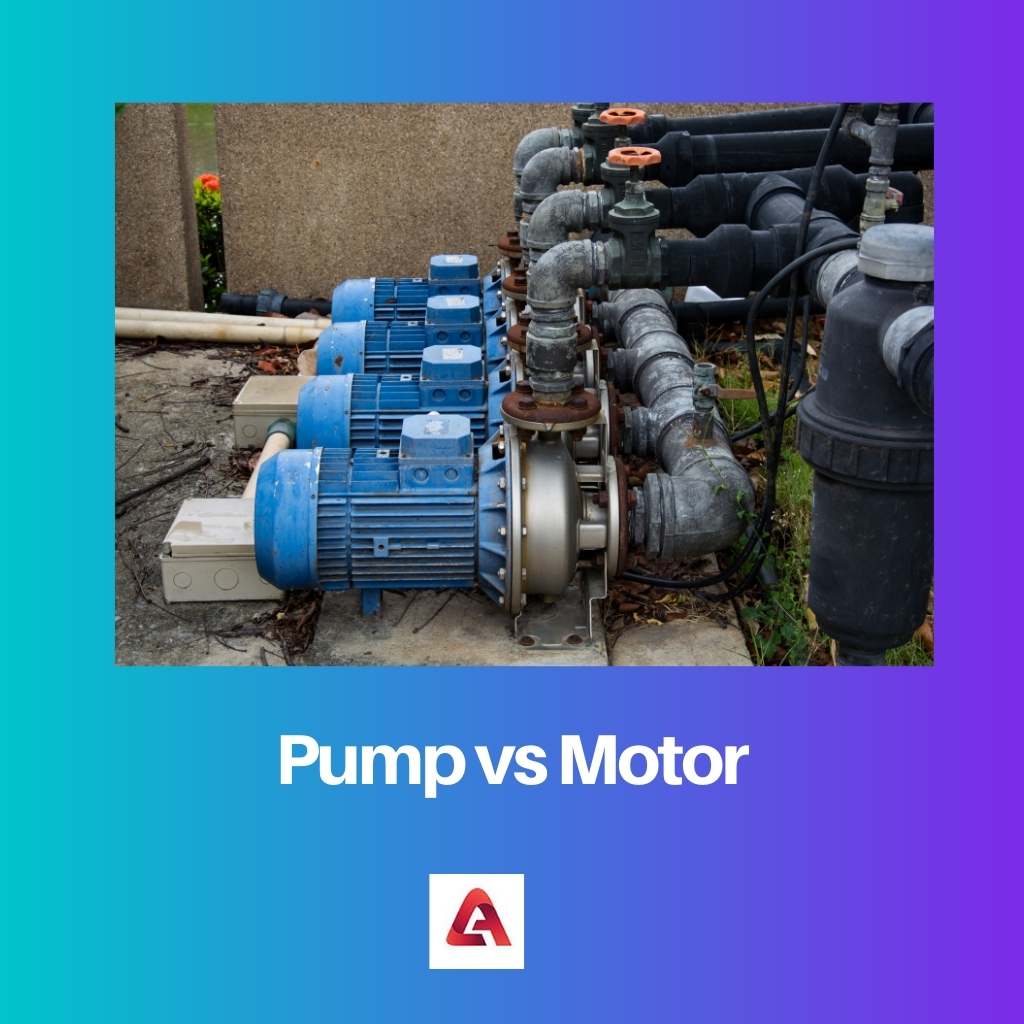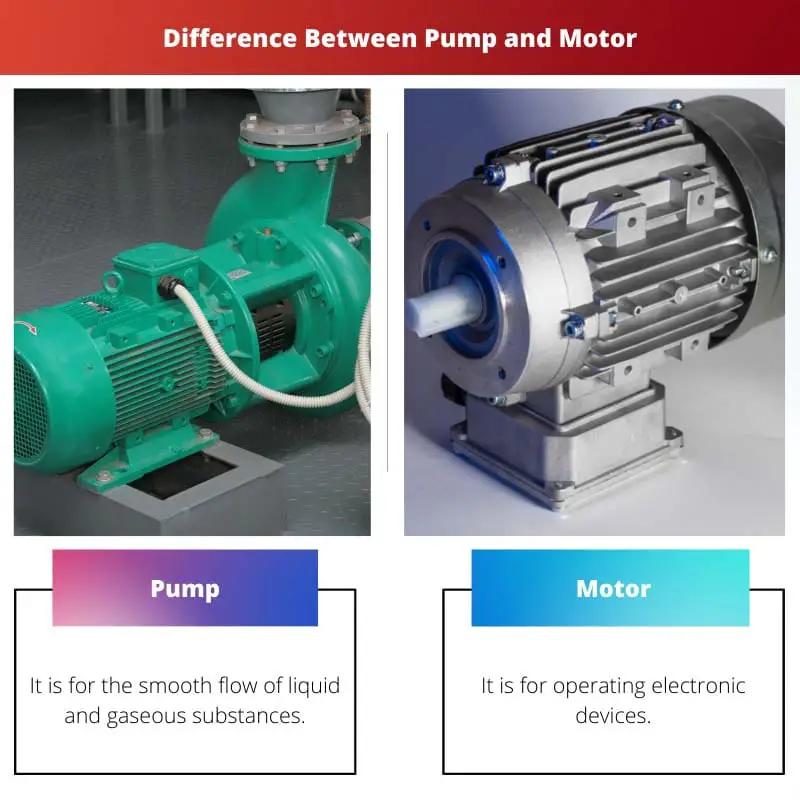Mechanical engineering is concerned with designing and operating mechanical devices that are primarily powered.
Mechanical devices are vital pieces of equipment utilized in multiple engineering professions, including civil engineering, automobile engineering, and many more.
We need to understand the two mechanical types of equipment.
Pumps and motors are mechanical devices that use electricity and are essential components of most electronic devices.
Pumps primarily function to raise or move the level of liquids.
Most motors are present in every machine, such as vehicles, heating devices, cooling devices, electronic toys, electronic kitchen appliances, and many other machines.
Key Takeaways
- A pump moves fluids by mechanical action, while a motor converts electrical energy into mechanical energy to power devices.
- Pumps are used in water distribution and cooling systems, whereas motors drive machines and appliances.
- Pumps can be classified as centrifugal or positive displacement, while motors are categorized as AC or DC.
Pump vs Motor
A pump is a machine that uses pressure and flow to transport fluids (such as liquids and gases) from one location to another. A motor is a machine that converts electrical or other forms of energy into mechanical motion and is commonly used to power pumps and other sorts of machinery.

The pump works on the principle of rotatory motion or linear motion. It is for raising the level of the substances (liquid, gases, and slurry).
We can say that it converts linear force into hydraulic energy by using suction. The suction creates a partial vacuum which creates pressure to lift the liquid.
The motor works on the principle of the law of electromagnetic induction and causes the conversion of electronic energy into mechanical energy. Motors can be controlled manually, electrically, or remotely.
It also works on the rotary motion by working on both alternative current (AC) and direct current (DC). Motors also consist of coils to create an electromagnetic field.
Comparison Table
| Parameters of Comparison | Pump | Motor |
|---|---|---|
| Purpose | It is for the smooth flow of liquid and gaseous substances. | It is for operating electronic devices. |
| Principle | It uses kinetic energy for creating pressure. | It uses the principle of Faraday law of electromagnetic induction. |
| Input-Output | It receives input as mechanical energy and output as hydraulic energy. | It received input as electricity and output as mechanical energy in rotation. |
| Used in | Irrigation, Gasoline supply. | Fans, Automobiles, etc. |
| Mainly Consists of | Mainly Consists of Inlet, Outlet, and Casing is part of a pump. | Magnets and Coils are there in a motor. |
What is a Pump?
A pump is a device that uses mechanical energy from electricity or manual labor to enhance the flow of fluids such as liquids, liquid-solid mixtures, and gases from one location to another.
It means the conversion of mechanical force by using kinetic energy into energy produced by water.
Each pump has three parts: an inlet, an outlet, and a casing. The substance enters the pump through the inlet. This side of the pump is known as the suction side.
The pressure at the liquid in the inlet is the lowest. The liquid is present in the casing section during operation.
Furthermore, the casing houses all of the interior components. The liquid is ejected from the outlet (discharge side). During the release, the substance is at its highest pressure.
Generally, there are two types of pumps in industries. A positive displacement pump and a dynamic pump are two types of pumps.
Both pumps have different internal workings. A positive displacement pump traps a fixed amount of liquid in the casing and enhances the pressure of that substance.
Several positive displacement pumps have an increasing cavity on the suction side and a decreasing cavity on the discharge side.
In the case of the dynamic pump, velocity or pressure is added to the fluid when it passes through the pump impeller (rotating iron). Subsequently, velocity is converted into the additional pressure to flow the liquids.
What is a Motor?
A motor is a mechanical device used in almost every machine which operates with electricity or without electricity.
When you start a motor, electrical energy is converted into a combination of kinetic (motion) and potential energy (stored energy).
A rectangular coil insulated with a copper wire is part of a motor. This coil is present between the two poles of electric energy.
Additionally, the ends of the coil are attached to the split rings, which are in turn attached to the axle (rod).
A source battery powers the current that travels through the conducting brush and into the coil to start a motor. Later, it returns to a battery via the other conducting brush. Some motors run on AC, while others run on DC.
Alternative current motor is of two types (synchronous and asynchronous) used in many appliances. A synchronous motor is used the least compared to an asynchronous, also called an induction motor.
Synchronous motors are present in machines that run at a set pace or have a fixed revolution per minute (rpm).
As a result, it’s embedded in printing presses and power plants. However, induction motors are commonly used motors in fans, water pumps, etc.
Direct current motors work on the simple method and are present in cooking inductions, elevators, cranes, driers, etc.
Main Differences Between Pump and Motor
- A pump is constructed for the flow of fluids. However, a motor is for starting the gadget on electricity.
- A pump can be a positive displacement or a dynamic pump, each with its own set of workings. On the other hand, the motor comes in multiple types (synchronous, asynchronous, permanent magnetic, series motor, and compound motor).
- A pump’s principle is based on kinetic and potential energy. On the contrary, the motor works on the electromagnetic field.
- A pump can be present in shampoo bottles (manual) and water pumps (electrical). However, a motor is present in machines.
- A pump mostly takes the aid of a motor to start. On the other hand, the motor takes the assistance of either alternating current or direct current to run.

- https://www.jstage.jst.go.jp/article/isfp1989/2008/7-1/2008_7-1_59/_article/-char/ja/
- https://www.diva-portal.org/smash/record.jsf?pid=diva2:479598

The article was fairly informative and valuable. However, the topic is very technical and in my opinion, the content was a bit dry.
I agree, it was somewhat dry but that didn’t discourage me from finding the information highly beneficial. It’s a smart and well-researched article.
This was definitely a detailed breakdown of pumps and motors, but it wouldn’t hurt to have a lighter tone to make it more engaging.
The proper explanation of pumps and motors is more than welcome. I’m a scientist and I found the article highly informative, I will be sharing it with my colleagues.
This is considerably informative and well-researched, congratulations to the author. I was thoroughly engaged and would like to see more from them.
I honestly learned a lot with the information provided with regards to pumps and motors, a truly outstanding piece of work.
I found the section on the functional differences between pumps and motors highly enlightening and insightful. I now have a better understanding of the mechanics involved.
It was a wonderful exploration of pumps and motors, providing profound insights into the machinery. The in-depth detail is truly commendable.
The comprehensive contrast of the mechanisms behind pumps and motors was presented in an engaging manner, making it an enjoyable and enlightening piece.
The article paints an intellectually captivating picture of the intricate workings of these mechanical devices, serving as a valuable reference.
Incredibly detailed, I truly appreciated the comprehensive and exhaustive comparison, please keep it up! I’m always on the lookout for articles of this quality.
This explanation has basically opened up my mind! I am truly impressed and I have a much higher understanding of the topic after reading the article, thank you!
The information throughout was well-compiled and insightful. I found this to be an extraordinary read that gives substantial knowledge.
I think the detailed comparison between a pump and a motor was exceptionally well-presented and very helpful. I’m looking forward to more.